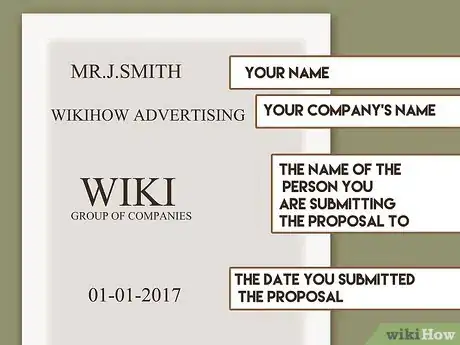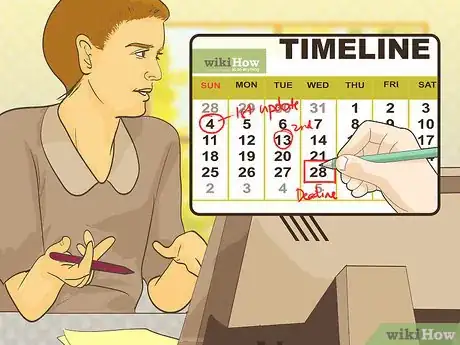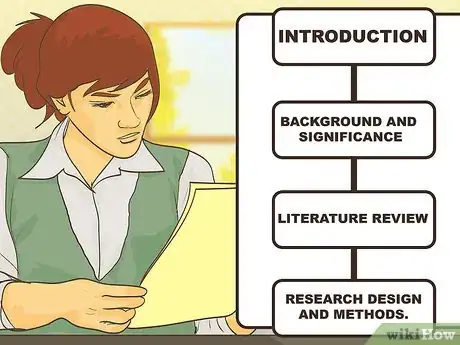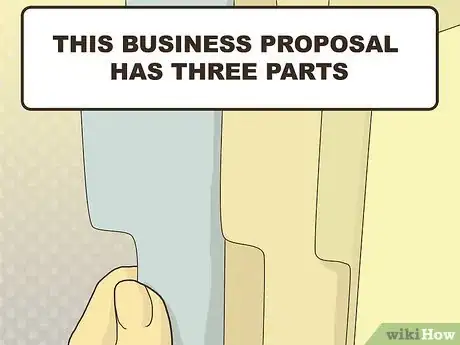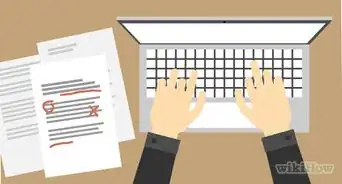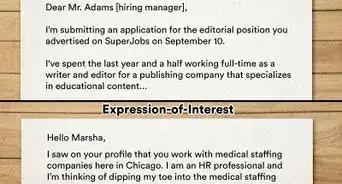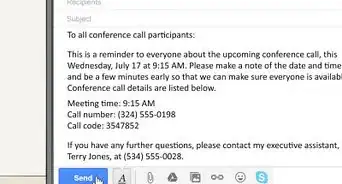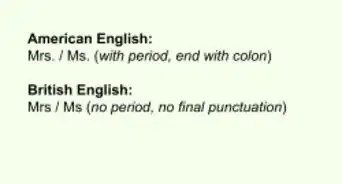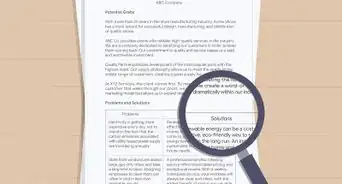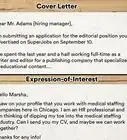This article was co-authored by Dave Labowitz. Dave Labowitz is a Business Coach who helps pre-entrepreneurs, solopreneurs/entrepreneurs, and team leaders start, scale, and lead their businesses and teams. Before beginning his coaching career, Dave was a startup executive who spent over a decade building high-growth companies. Dave’s “path less traveled” life includes adventures such as dropping out of high school, co-authoring a book in the Smithsonian Institute, and getting his MBA at Pepperdine’s Graziadio Business School.
There are 10 references cited in this article, which can be found at the bottom of the page.
wikiHow marks an article as reader-approved once it receives enough positive feedback. In this case, 81% of readers who voted found the article helpful, earning it our reader-approved status.
This article has been viewed 365,991 times.
A “formal proposal” is a phrase that has two different meanings. In business, a formal proposal is a kind of offer to provide a product or services. In the academic world, a formal proposal is a recommendation to conduct some kind of research. This article will teach you how to write both.
Steps
Writing a Business Proposal
-
1Study the Request for Proposal (RFP) carefully. Many businesses or governmental agencies will send out an RFP when they need goods or services. For example, a company that is being sued might send RFPs to specific law firms, asking them to submit a business proposal. Alternately, a government agency might send out an RFP when it needs to buy some product or materials. The RFP will generally contain details that you must fully understand before drafting your business proposal.[1]
- Be sure that you can provide the client’s needs as outlined in the RFP. For example, you need to be able to meet the proposed budget, timing requirements, and any other specifications that the client identifies.
- You may choose to submit a formal proposal without waiting for an RFP. If you believe some business could use your services, you may reach out to them on your own and submit your own formal proposal.
-
2Investigate the client’s needs. Your proposal should address the client’s actual needs. To write a strong proposal that will be useful to the client and that will help you earn the assignment, you should understand the client’s work and the need that you are addressing. If possible, you should contact someone at the company to get information. If the RFP is competitive, they may be limited in how much information they can provide. Nevertheless, you should make the effort and try to get answers to some of the following questions:[2]
- Find out if prior attempts were made to address the problem. If so, why did those attempts fail?
- Ask what criteria the client will use when evaluating a business proposal.
- Find out whether the company has any special concerns that you should address.
- Ask about the company’s operating policies. Your proposal should be consistent with these policies.
Advertisement -
3Use a formal title page. Your proposal should contain a title page as a cover. The title page should include the following information:[3]
- Your name
- Your company’s name
- The name of the person you are submitting the proposal to
- The date you submitted the proposal
-
4Introduce the problem that you are addressing. The formal proposal that you are submitting should identify a problem and propose a solution. Begin by identifying the client’s problem in simple and clear language.[4] Explain why the client should see that your understanding of the current situation presents a problem.[5]
- For example, a proposal to provide legal services might begin with the following introduction: “We are aware of pending litigation that has been threatened regarding your company’s acquisition of XYZ Corp. We offer this proposal to provide the legal services that you need.”
-
5Put your proposal in context. Unless you are responding to an RFP, you might need to provide some background to explain the reason for your proposal. For example, you may need to identify the following:[6]
- Prior attempts that have failed.
- Whether someone asked you to write the business proposal.
- How you became involved in the project or aware of the problem.
-
6Include definitions for key terms. Any particular industry terminology or other terms of art that you use in the proposal should be clearly defined. As much as possible, you should write in clear, simple language, but some technical terminology may be necessary.[7] You may be submitting your proposal to, for example, someone in a purchasing department who understands industry jargon, but the final decision may come from someone in administration who is not familiar with industry terms.
- You can draft the business proposal first and then go through to identify any terms that might be unclear to the reader.
- Also define terms if you are using them in a unique way. For example, the term “fiscal year” can be defined in many ways, depending on the business.
-
7Propose a detailed solution. After you open by identifying the problem, tell the reader how you will solve that problem. Provide as much detail as you can.[8] Typically, the solution that you propose will be for the company to hire you or your company, or purchase your product.
- For example, you might offer: “Acme Accounting specializes in Accounting and Payroll Services for growing small and mid-sized businesses. We can provide complete service in the following areas: ledger maintenance, inventory account balancing, year-end tax statements and summaries, and standard pay period check origination.”
-
8Explain why your solution is the best. You are either suggesting something that the client has not considered yet, if you are presenting a proposal that has not been requested, or you are in competition with other companies, if you are responding to an RFP. In either case, you must explain why the solution that you present in your proposal is the best option for the client. You may wish to use bullet points to highlight key benefits. Common benefits include a cost savings to the business, confidentiality, and professional expertise.
- Provide evidence to justify your expected benefits. For example, if you have studies or industry data that support your proposal, you should include them.[9]
-
9Present your proposed task schedule. Include a timeline for completing the tasks that are key to your proposal.[10] At the proposal stage, it is understood that the details may change in the future, but it is important to give the reader some idea of how you will go about executing your proposal.
- Highlight certain milestones. For example, if you propose to remodel a store, you should include your beginning date and finishing date, so the client will know when the store can reopen.[11]
- Include a warning that your timeline is an estimate and may depend on other factors that could be out of your control. For example, a proposal for a construction job could be delayed by having to obtain the necessary permits from the local government or by relying on a subcontractor.
-
10Provide a budget. The client needs to know whether they can afford your services, so the budget could be the most important part of your proposal. You also may be competing against other companies trying to get the same job. You should include information about pricing. Be conservative. For example, you might want to add up the anticipated budget and then multiply by 1.5 to account for any unforeseen circumstances.[12] Include a disclaimer stating that the numbers are only estimates. Some details that you may choose to include are:
- start-up costs or initial set-up
- labor costs
- supply costs
- ongoing monthly charges
- maintenance costs
-
11Include key contract terms. If your proposal is to form the basis of a contractual agreement between you and the client, you should include key contract terms. For example, you could include information such as the following:
- How much is paid on signing: “50% payment upon signing.”
- Penalties or interests assessed for late payment: “A late fee of $50 will be assessed on any account past due.”
- Your cancellation policies: “The contract may be cancelled for any reason with 90 days written notice. There are no pre-payment penalties.”
-
12Outline your relevant experience. To be selected to provide the service or product in question, the client should have confidence that you can follow through and implement the business plan.[13] Describe one or more similar projects that you have worked on and explain the success you achieved.
- Be careful not to exceed any client confidentiality agreements you may have with other clients. Nevertheless, you can describe your prior experience in general terms. For example, you could write, “Successfully provided Accounting and Payroll Services to 20 mid-sized businesses (25-100 employees) for the past five years.”
-
13Identify others who will be working on the project. You or your company may not be able to do everything to address the client’s needs. In this situation, you should explain how you will get the necessary support from other sources. Additionally, explain how you will guarantee that any other workers are competent to complete their assigned tasks.
- If available, you should include resumes along with the business proposal.[14]
-
14Provide references. If your proposal makes reference to studies, written reports, data compilations or other sources, you should them at the end. Format them using a well-known style, such as APA style.
- Including a list of sources allows the client to verify your information easily.
- Encourage the client to contact you with questions. Provide your website, in case the client would like to see more information about your business.
Writing an Academic Proposal
-
1Begin by selecting the topic for your research. Unless you are in a class where a topic is specifically provided to you, you will need to select the topic for your research. This should be based not only on your own interests and expertise, but also on an academic need to answer some particular question. Think about the following questions in selecting your topic:[15]
- What topics interest you enough to research and write about?
- Is the topic important enough, and why?
- What problems or open academic questions will your research answer?
- How does your proposal build on research that has already been done?
- Can you accomplish the research in the time allotted?
-
2Outline the structure of your proposal. Before you even begin writing, you need to have a plan for your project and the written proposal. By setting out an outline, you will give your research a direction and purpose. In general, most academic proposals should include the following sections:[16]
- Introduction
- Background and significance
- Literature review
- Research design and methods.
- Conclusion
- Citations
-
3Begin with an introduction. This will be the section that provides the basic proposal and explains the topic that you seek to research. You will introduce the topic and the research methods that you plan to use. You should also explain briefly why this topic is important enough to consider.[17] In the introduction, consider the following questions:
- What is the main field of your research?
- What is the specific topic of study related to that problem?
- What methods will you be using to analyze the research problem?
- Why is this research worthwhile? What is its significance?
- Why would someone reviewing your proposal be interested in the results of your research?
-
4Explain the background and significance of your project. This is the section of your proposal that will address the reason for your project. Explain the academic context for your proposed research. Provide some basis of work that has already occurred on your particular topic, and where it has left off. Discuss how you will progress from there, and why your proposed topic is worth the work that you will put into it.[18] In this section, you will address:
- The primary research problem. Explain the purpose of your study beyond the brief introduction you started with.
- The rationale of your proposed study. Explain why this project is worth doing. Anticipate and explain why anyone would care about the outcome of your research.
- The major issues or problems to be addressed by your research. Address the ways in which your proposal expands on previous assumptions and beliefs about the topic.
- Explain how you plan to conduct your research. Define the primary sources you will use and their contribution to your analysis.
- Focus your research. Provide the boundaries for your particular project. If there are related issues that you are specifically not addressing, explain what those are.
-
5Review the main sources of academic literature. Whether your proposal consists of scientific research in a laboratory, psychological research consisting of observing human subjects, or analysis of particular literature or history, you will be relying on some academic literature as a basis. This section of your proposal is to explain that academic literature and its effect on your project. You need to put your research in a greater context and show how you advance or contradict earlier work.[19]
-
6Describe your research methods. In this section, you need to explain very thoroughly what you intend to do, and why your proposal is worth doing. This is the primary section that will convince your reader that your proposal is not only beneficial but also well-planned and worth pursuing. You need to show that you know what you are doing and that your proposal is the best way to answer the questions you have raised in prior sections. Include the following details:[20]
- The specific tasks and steps you will undertake. With each step, include a description of the reason for it, and how that step will add to the research project as a whole.
- Comparisons to other prior research. If your academic review has found other, similar projects or research, you should discuss how your methods will differ. Explain why the difference is important, and what you intend to show by using your method.
-
7Recognize limitations of your proposal. Part of the responsibility of making a formal proposal includes recognizing limitations or problems you could face. Certainly, you want your proposal to be accepted. However, you do not want to get accepted and then have problems arise that could surprise your supervisors or supporters. In this section, you should mention the following:[21]
- Materials and budget. If you need financial support for your research, this is the section to include a budget. Provide a list of the materials that you will be using, and explain why they are critical to your work. If other, cheaper supplies are available, explain why you propose to use what you do. Be aware of any limitations that have been placed on any proposals.
- Acknowledge potential problems you anticipate. At the outset, you should consider difficulties that may arise. Address them here, and how you believe you will address them.
- Provide a timeline.
-
8Wrap up with a conclusion. Repeat the need, as you see it, for conducting this research. Summarize the key points of your purpose and your project design. Impress upon the reader that your proposal will advance some important academic question, and explain why. You want the reader to come away with the same understand, belief, and passion for the topic that you have.[22]
-
9Provide your citations. Follow whatever format you have been assigned or that is customary at your institution. You may include a list of references or a complete bibliography of sources. In either case, the purpose is to justify your proposal and allow the reader to review and even check parts of your proposal as necessary.[23]
Remembering Tips for Any Formal Proposal
-
1Present your proposal in a professional format. Your proposal should be readable and present a strong appearance. Unless the RFP or your instructions specify something different, you should use a clear, readable font, in a size and style that will be comfortable for the reader. Generally, Times New Roman 12 point font presents a strong, professional appearance.
- You might also review sample proposals used in your industry. Search the Internet for “proposal sample” and some details about your particular business field.
- You may also find business proposal templates online. Using one of these templates can make your proposal look professional.[24]
-
2Provide a road map for the proposal. If your proposal is lengthy or complicated, you should offer an overview of what follows the introduction.[25] You could summarize the parts that follow the introduction.
- For example, you could write, “This business proposal has four parts. After this introduction, we offer the proposed solution, timetable, and an explanation of benefits in Part II. In Part III, we provide an itemized budget and a set of standard contract terms. Finally, in Part IV, we summarize our experience and confirm that our proposed solution is the correct course of conduct.”
-
3Proofread and edit your proposal before submitting it. Unless time is critical, set your draft aside for a day or two and then review it. Look for typing errors and dropped words. Also pay close attention to your numbers and make sure they are accurate.[26]
- You also should review the RFP again, along with any relevant correspondence. Make sure your proposal contains everything that the client has requested that you address.
- Shorten the proposal, if necessary. Ideally, someone should be able to read your proposal in eight minutes. If it takes longer than that, then try to move as such material into an appendix.
Community Q&A
-
QuestionHow do I write a counseling proposal to apply for the position of a school counselor?
 Community AnswerWhat your question describes is really more of a job application than a counseling proposal. But if you are suggesting that the school needs to hire you, and your proposal is not in response to a job posting, then you may wish to follow the outline of a formal proposal. Explain to the school why they need a counselor, and why you believe that you are the best one for the job.
Community AnswerWhat your question describes is really more of a job application than a counseling proposal. But if you are suggesting that the school needs to hire you, and your proposal is not in response to a job posting, then you may wish to follow the outline of a formal proposal. Explain to the school why they need a counselor, and why you believe that you are the best one for the job. -
QuestionHow can I write a Formal Proposal when I'm starting a new company?
 Community AnswerIn proper format use your name, address, phone number, job, interest about the job and experience.
Community AnswerIn proper format use your name, address, phone number, job, interest about the job and experience. -
QuestionHow can I create a project proposal for non-readers?
 Community AnswerI assume (hope) that you mean you have a proposal to teach reading, and not that you want to propose something to people who do not read. (That would be a real challenge.) Identify the problem as having too many individuals -- of whatever age group you wish to identify -- who cannot read. Then describe how you would solve the problem, what services you can provide, what it would cost, and why your solution is the best one to select.
Community AnswerI assume (hope) that you mean you have a proposal to teach reading, and not that you want to propose something to people who do not read. (That would be a real challenge.) Identify the problem as having too many individuals -- of whatever age group you wish to identify -- who cannot read. Then describe how you would solve the problem, what services you can provide, what it would cost, and why your solution is the best one to select.
References
- ↑ https://www.entrepreneur.com/article/21834
- ↑ https://www.entrepreneur.com/article/21834
- ↑ http://articles.bplans.com/whats-the-best-business-proposal-format/
- ↑ https://blog.bidsketch.com/articles/how-to-write-a-business-proposal/
- ↑ http://writing2.richmond.edu/writing/wweb/business/proposals.html
- ↑ http://writing2.richmond.edu/writing/wweb/business/proposals.html
- ↑ http://writing2.richmond.edu/writing/wweb/business/proposals.html
- ↑ https://blog.bidsketch.com/articles/how-to-write-a-business-proposal/
- ↑ http://writing2.richmond.edu/writing/wweb/business/proposals.html
- ↑ https://www.thebalance.com/how-to-write-a-business-proposal-2951436
- ↑ http://writing2.richmond.edu/writing/wweb/business/proposals.html
- ↑ http://fitsmallbusiness.com/how-to-write-a-business-proposal/
- ↑ http://writing2.richmond.edu/writing/wweb/business/proposals.html
- ↑ http://writing2.richmond.edu/writing/wweb/business/proposals.html
- ↑ http://libguides.usc.edu/writingguide/
- ↑ http://libguides.usc.edu/writingguide/
- ↑ http://libguides.usc.edu/writingguide/
- ↑ http://libguides.usc.edu/writingguide/
- ↑ http://libguides.usc.edu/writingguide/
- ↑ http://libguides.usc.edu/writingguide/
- ↑ http://libguides.usc.edu/writingguide/
- ↑ http://libguides.usc.edu/writingguide/
- ↑ http://libguides.usc.edu/writingguide/
- ↑ https://business.tutsplus.com/tutorials/how-to-write-a-winning-business-proposal--cms-25755
- ↑ http://writing2.richmond.edu/writing/wweb/business/proposals.html
- ↑ https://business.tutsplus.com/tutorials/how-to-write-a-winning-business-proposal--cms-25755
About This Article
The best way to write a formal business proposal is to introduce the problem and the solution. Then, present a task schedule and budget. To write a formal academic proposal, start with an introduction that explains the topic you want to research. Then, write a body that mentions research literature and methods, and add a summarizing conclusion. For general tips on how to write formal proposals, as well as more specific guidelines for formal business and academic proposals, read on!


